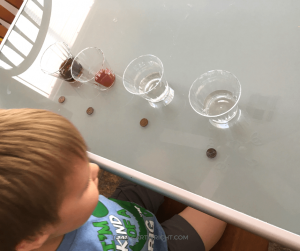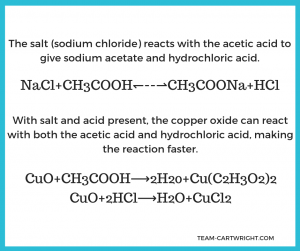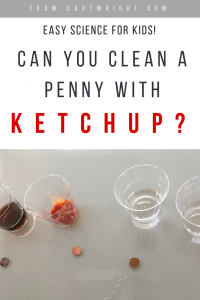Cleaning pennies with ketchup: easy and fun STEM for kids.
Want to wow your kids with some simple kitchen science? (Or have a fun science fair project?) This is a fun and easy STEM activity that introduces the idea of oxidation and basic chemical reactions. All with pocket change actually.
You are going to challenge your children to clean pennies with various kitchen condiments. The unlikely condiment you need to be sure to include? Ketchup. Trust me on this. Your kids will love this simple chemistry experiment.
It is a great sensory STEM activity for preschoolers and older children. Here is the science of cleaning pennies with ketchup.

What's In This Post?
Cleaning Pennies with Ketchup: The Activity
You Need:
- Dirty Pennies
- Small Cups
- Ketchup
- Water
- 2 or More Additional Solutions. Examples: Vinegar, Coke, Mustard, Mayo, Juice, Milk, Lemon Juice, etc.

The Set-Up
Here is how to set up your cleaning pennies experiment.
Pour a small amount of each solution you chose into a cup. Be sure to include one water cup as a control and one ketchup cup. If you are in a hurry these two cups can be enough, but more solutions are better to give a full picture of what is happening. Take a few minutes to examine your chosen solutions. What do they look like? How do they feel? How do they smell? Don’t be afraid to use all your senses.

Take the dirty copper pennies (the ones from the bottom of your purse are best) and have your child place one into each cup. Be sure the penny is coated in whatever solution is in that cup. This is easy for the water and other thin liquids, but for ketchup or mustard, you need to flip the penny around to be sure it is coated.
Let the pennies soak for a little bit. Place a square of clean, white paper towel in front of each cup. This will be where you place your coins for comparison. Have additional paper towels available to wipe off any remaining solution from the pennies.
The Comparison
After all the pennies have soaked for about five minutes, it is time to pull them out. Carefully remove each penny from its solution. Gently wipe off any excess solution with a paper towel. Once they are clean place them on the towels you laid out in front of the cups.

(Keeping the pennies in front of the cups will help you remember which solution they were each in. If you are doing this with older children who can write you can have them write out a grid for penny comparison. Younger kids who can’t yet write well can keep the pennies in front of the cups.)
Now check out your pennies. Which one is the cleanest? Which one is still the dirtiest?
The Results
You might be surprised at how well the ketchup cleaned the penny. I know I was.
Rank your solutions from which cleaned the penny the best, to which cleaned it the worst. Were you surprised by the results? Why or why not? What changes could you make to the experiment to get even cleaner pennies? Could you have cleaner pennies if you just used running water?
Cleaning Pennies with Ketchup: The Science

Why Do Pennies Get Dirty?
Why do pennies get dark and dingy? I’m not talking about the literal dirt that ends up collecting on them I’m talking about the residue that is still present even if you rinse your pennies off with water. This ‘dirt’ is actually copper oxide.
Oxygen in the atmosphere has a negative charge that is attracted to the positive charge of the copper in the penny. They react to form copper oxide, which is darker in color. This is why bright shiny pennies dull with age.
Chemical Reaction
When we clean copper pennies this way, we aren’t just rubbing dirt off of them. We are actually performing a chemical reaction that breaks down the copper oxide. What works best to do this is an acid combined with salt.
Ketchup is a weak acid (from the vinegar), and this acid breaks down the copper oxide. The salt in the ketchup adds dissolved chloride ions that bond with the copper to form copper chloride, which allows the acid to break up even more copper oxide. The acid in ketchup is acetic acid, commonly known as vinegar. This is a weak acid, which is good since we ingest it. The salt helps speed up the reaction.

Cleaning Pennies with Ketchup: The Scientific Method
This is a great activity for using just exploring and giving open-ended questioning. It can be done relatively quickly and with multiple ages. But if you really want to dig in you can guide your children through the scientific method while doing this. No, the scientific method isn’t a chore. And it actually has a lot of practical life lessons wrapped up in it. (Don’t believe me? Read this: Life Lessons from the Scientific Method.)
Scientific Method Questions
Here are the scientific method steps and some sample questions to help you work through it.
- Question. Ask a question. Here the likely one is ‘Which substance will clean the penny the best?’
- Observe. Take a look at the pennies. Then think about the solutions in front of you. What do you know about these things?
- Hypothesis. Take an educated guess. Which substance do you think will clean coins best? Why?
- Experiment. Perform the activity!
- Analyze Your Results. Take a look at your pennies and compare which is cleanest.
- Reach a Conclusion. Which substance cleaned the pennies best? Why do you think that is?
Once you have completed the process don’t be afraid to go back and work through it again. Science isn’t a one and done thing. Keep trying, keep asking why, and keep learning.

Take It a Step Further
You don’t have to stop after doing this once. Try more solutions. Make your own mix of vinegar and salt at different concentrations. Try leaving the pennies in the solutions for different lengths of time. Make this your own and let your kids explore. Who knew learning how to clean a penny could be so much fun?

You can read more on the science behind how to clean pennies here:

How To Clean Pennies with Ketchup
Clean your pennies with ketchup! This easy and fun science experiment teaches kids about chemical reactions in a way that seems like magic!
Materials
- Ketchup
- Pennies
- Paper Towels
Tools
- Plate
- Paper Towels
Instructions
- Gather up a few dirty pennies.
- Set one penny aside to act as your control.
- Put a dollop of ketchup on a plate. Place a penny in it and cover the penny with ketchup.
- Wait for about 5-10 minutes.
- Wipe the penny off with a paper towel and rinse off.
- Compare the penny from the ketchup to the control penny. Look how much cleaner it is!
Notes
Safety
This is a pretty safe experiment. Make sure your child doesn't lick the pennies or try to eat any because ketchup is tasty.
Clean-Up
Wipe the excess ketchup off the pennies, then rinse them off. You can dispose of any extra ketchup how you normally would.
And be sure to share these additional fun learning activities with your kids! Just click on the image to find more science fun.









rebecca
Wednesday 22nd of April 2020
Thanks for sharing! I'm a teacher, currently doing distance learning with my students during the school closure and I'm going to use your activity for our Weekly STEM Challenge! I'm giving you a shout out on the post.
Kim
Wednesday 22nd of April 2020
I'm so glad you liked it! Thank you for sharing!
Toni
Tuesday 4th of September 2018
This looks like a great activity to do with my kiddos! They are going to love it!
Krystal Miller
Tuesday 4th of September 2018
I needed a quick science activity. We're going to try this out today!